Dragalia Lost: ¿Nintendo ha descubierto el Free-to-Play?
No hace mucho, Nintendo prometió nunca hacer que los juegos móviles fueran gratuitos. Su propio hardware es demasiado importante, el “factor Nintendo” es incompatible con los juegos gratuitos. Primero, cedieron en hardware, con el lanzamiento de Mario y luego en el juego gratuito mediante la colaboración con Niantic, creando el superéxito Pokémon Go. Siguió una historia de éxito irregular, con algunos proyectos como Fire Emblem Heroes convirtiéndose en éxitos y otros, como Pokemon Quest y Animal Crossing, oportunidades para aprender. ¿Es Dragalia Lost una prueba de que Nintendo puede lograr un éxito continuo en dispositivos móviles o es otra oportunidad perdida?
Tanto Pokémon Go como Fire Emblem Heroes se consideran un éxito sorpresa, superando ampliamente las expectativas. Dragalia Lost, a su vez, es una unión mucho más predecible, con antiguos Cygames gratuitos (famosos por Rage of Bahamut) que añaden un diseño de monetización probado y demostrado y conocimientos expertos en sistemas a los famosos estándares de calidad y construcción mundial de Nintendo.
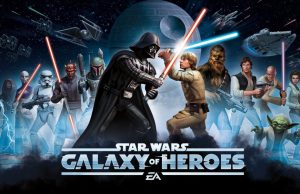 Lectura relacionadaDeconstruyendo la galaxia de los héroesEn deconstruccionesAdam Telfer
Lectura relacionadaDeconstruyendo la galaxia de los héroesEn deconstruccionesAdam Telfer
Escrito por Florian Ziegler , que acaba de poner en marcha su consultoría Lava Lake ; con adiciones de Adam Telfer.
¿Qué tan bien le está yendo a Dragalia Lost?
Dragalia Lost ha tenido un planteamiento de lanzamiento extraño. En lugar de lanzarse en mercados menores que se comportan de manera similar a sus mercados principales (por ejemplo, Canadá, Australia), Nintendo lanzó Dragalia primero en Japón, Hong Kong y Estados Unidos. Un lanzamiento suave y audaz, pero en el que verán claramente el éxito del juego.
Hasta ahora, aproximadamente 40 días después de su lanzamiento, el juego inicialmente alcanzó su punto máximo en las listas de mayores ingresos de EE. UU., pero desde entonces ha caído. Ahora todavía está cayendo del Top 250 de recaudación.
Entonces, ¿el juego está funcionando mal? No necesariamente. La tienda de aplicaciones japonesa cuenta una historia diferente:
Si bien en los EE. UU. el juego se está desvaneciendo rápidamente, este juego parece ser un nuevo elemento básico en las listas japonesas de mayores ingresos.
Sin embargo, lo que envía señales de que este juego puede ser un contendiente es que estos rangos de recaudación se han mantenido a pesar de que el juego disminuyó significativamente en descargas. Este es un lanzamiento suave, no un lanzamiento global, por lo que es poco probable que Nintendo haya puesto mucho esfuerzo en comercializar el juego todavía. Hasta ahora, Sensor Tower estima que el juego ha acumulado más de 2 millones de descargas en el lanzamiento preliminar, pero ya ha generado más de 27 millones de dólares .
Sin embargo, para poner esto en contexto histórico, comparemos el lanzamiento de Dragalia Lost en los EE. UU. con Fire Emblem Heroes, el juego gratuito de Nintendo con mejor rendimiento hasta la fecha:
Sorprendentemente, el juego está alcanzando aproximadamente los mismos números por usuario en este momento, lo que es un fuerte indicador de éxito. Por lo tanto, es probable que, aunque el juego esté desapareciendo de las listas de mayores ganancias en los EE. UU., en realidad esté funcionando bien por usuario.
Entonces, la verdadera pregunta es: ¿puede Nintendo hacer crecer efectivamente este juego al mismo tamaño que Fire Emblem Heroes? ¿Podrá Nintendo repetir el éxito de Fire Emblem con una nueva IP?
Introducción a Dragalia perdida
Dragalia Lost lleva a los jugadores a un mundo familiar de alta fantasía, en el que los humanos forman vínculos especiales con dragones para mejorar sus poderes. A diferencia de los títulos anteriores de Nintendo, Dragalia es una IP completamente nueva, que se basa completamente en personajes de alta calidad y una experiencia bellamente diseñada para atraer a los jugadores.
Jugabilidad de la fase de acción
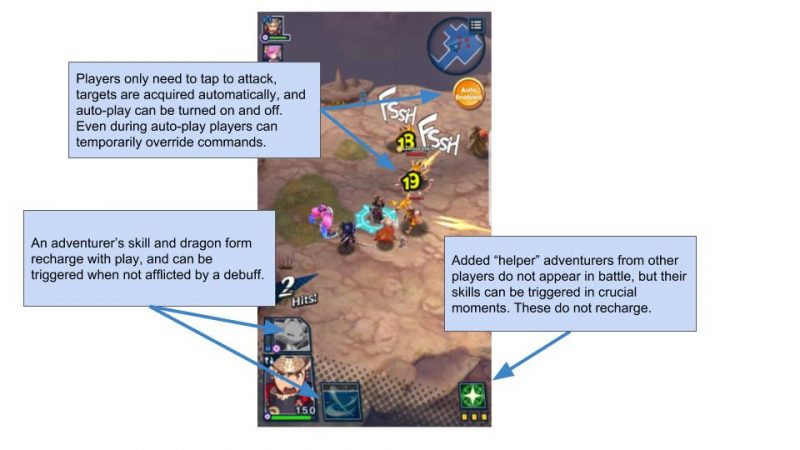
La fase de acción de Dragalia es un juego de rol de acción en 3D de arriba hacia abajo. Los jugadores pueden usar un solo toque para atacar, mover el pulgar para dirigir y activar habilidades especiales de sus personajes o su forma de dragón. La jugabilidad es muy similar a la de los juegos de rol de acción móviles previos al período de inactividad como White Cat Project, con un botón "automático" opcional que esencialmente lo convierte en Nonstop Knight.
Todo se juega fácilmente con una mano y un dedo en modo vertical, lo que lo hace muy accesible. El juego automático es relativamente eficiente y, si tienes el metapoder necesario, solo tienes que activar habilidades cuando estén listas y, de lo contrario, ver cómo se desarrolla el juego.
Tomar el control manual solo es útil para maximizar las recompensas de las cajas del tesoro que a veces están fuera del camino de combate de la IA, o para jefes especiales que requieren un posicionamiento y esquiva más cuidadosos de lo que los algoritmos de control son capaces de hacer.
En general, el combate es lo suficientemente informal como para dejarlo solo, pero tiene el potencial de un juego de incursiones contra jefes profundo, que el juego ofrece a los jugadores comprometidos.
Las batallas de rutina ya completadas se pueden omitir con tickets de omisión, que no se monetizan.
Fase previa a la batalla
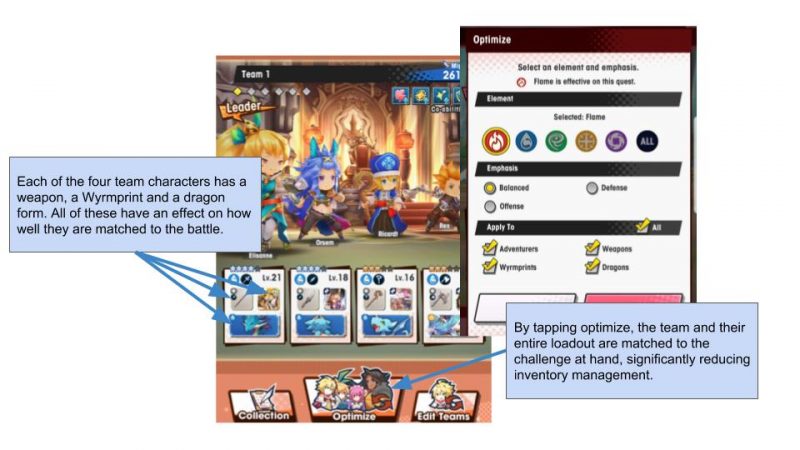
Como unión entre la fase de acción y el metajuego, la fase previa a la batalla es donde los jugadores determinan la estrategia y el equipamiento de su equipo. La clave para ganar es la alineación elemental de los personajes (fuego, agua, viento, oscuridad y luz) y cómo se corresponde con la batalla en cuestión. Otro factor es la clase del personaje (ataque, apoyo, defensa y curación) y el arma asociada (espada, hacha, daga, sable, lanza, arco, bastón y varita).
As the combat allows for this kind of depth, badly constructed teams (such as all support characters) tend to fail frequently, giving players another reason to maintain a large roster of characters.
With four characters, each with three potential slots (weapon, Wymprint and dragon form), making the right choice can be a complicated undertaking. Cygames has, however, simplified the process massively by giving you an optimization button that tailors the setup to whatever is the most effective elemental setup at hand. This means the amount of character and item management is massively reduced compared to other games of this type.
Systems Overview
Gacha RPGs essentially run on their system design, and from a systems standpoint, Dragalia is a massive game. To understand how it can generate the staggering $15 ARPI per player, the best way is to showcase the immense breadth and depth of its progression system.
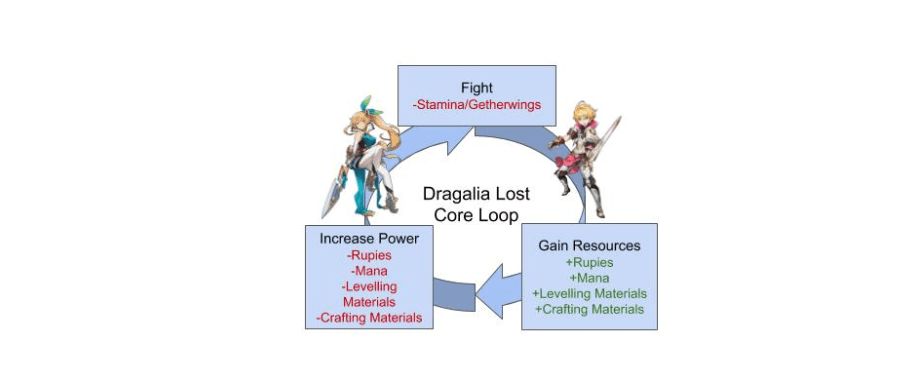
As you can see, the game follows the classical trinity core loop of fight – get resources – upgrade. Where many games keep this pretty straightforward and potentially expand in the future, Dragalia comes with an an astonishing array
That’s a lot of game! We will go through these systems one by one to explain how they work.
Adventurers
Players acquire adventurers from events and the gacha system, ranging from 3-5 stars in rarity. Adventurers have one of five elements (wind, fire, water, dark and light), and can each be equipped with a weapon, a Wyrmprint (essentially an upgradable ability) and a dragon form into which they can morph during battle.
Adventurers gain XP by battling, but can also be levelled with an XP currency called crystals. Duplicate adventurers are converted to Eldwater, which in turn allows 3 and 4 star adventurers to be “unbound” meaning they can become 4 and 5 stars respectively.

Additionally, each adventurer has a “mana circle” which is essentially a character’s skill tree. It unlocks stat bonuses and skills, and it, too can be “unbound” using special materials only found on certain recurring weekday events. The amount of mana circles (and hence power options) depends on rarity, and lower rarity characters need significant amounts of investment to break their limits to unlock them.
Dragons
Adventurer’s can turn into dragons for a limited time during combat, giving them strong power increases and new special abilities. Dragons can be levelled using a special dragonfruit currency to increase their power up to a certain level cap. Getting duplicates of a dragon allows the dragon to be “limit-broken”, meaning they can now have a higher level limit cap for further upgrading.
As an additional action, players can visit their dragon’s roost and give them gifts in the form of Rupies (Dragalia’s soft currency). In turn, the bond strengthens, which gives the player more time to use the dragon form. The dragon returns the gift by bestowing random item rewards onto the player.
Dragons have individual elemental alignments, and it is possible to give a fire adventurer a water dragon, in case a player cannot muster the right high-level elemental fighters for a specific challenge.
Wyrmprints
Wyrmprints are equippable trading cards that add or alter the adventurers ability. They, too, can be levelled using their own currency and limit broken with gacha duplicates. This means that to fully level up a 5 star top rarity Wyrmprint, you would need to acquire four duplicates (appearance rate of a specific 5 star Wyrmprint is 0.083% at the time of writing) and then acquire enough specific levelling materials or dud Wyrmcards to feed into them to level them up.
Some Wyrmcards are event specific (such as the anti-boss card shown above) and are needed to get the necessary horsepower to beat the bosses at highest levels, creating the need to go through the entire journey to max out an item that is not very useful outside the event. This is a powerful way to monetize whales that have all other standard game content already.
Like dragons, they can be equipped onto any character, but usually inherently are the right choice for certain classes (such as bestowing healing bonuses onto healers).
Weapons
Weapons can be found or crafted, and are not found in the main gacha. Crafting them requires rare materials that players have to grind, gacha or purchase. Just like dragons and Wyrmprints, they are levelled and limit broken with their own currencies.
Rare elemental versions of weapons can be created, which give 50% damage bonuses to characters of the same alignment. The 4 star and 5 star versions of the elemental weapons tend to be very hard to craft, with very rare materials involved, but crucial to late game success.
Being able to craft these high level weapon in the first place is dependent on the Smithy building in the Halidom.As a further connection between Halidom and the weapons system, after a substantial amount of time in the campaign, Dojos can be built to give buffs to your various weapons.
Dependence of the weapon system on the kingdom builder part of Dragalia forces players to have a steady predictable progression metaphor that is based on time, not random drops, until they can craft endgame items.
Halidom
The Halidom is a kingdom builder, and plays by the standard rules of builder conventions. Buildings costs soft currency, time and sometimes crafting materials to build, and there are a limited amount of builders. Building can be finished up quickly for hard currency. Buildings generate resources that can be collected when they are full, and unlock certain features in the game (such as weapon crafting).
Some of the buildings buff your weapons’ and adventurers’ combat power across the board, making progression in the Halidom a long term necessity. On top of that the economic gains the player requires towards higher levels make the return-to-collect mechanic a great retention driver.
Why have all these parallel systems?
As you can see, Dragalia Lost contains a character gacha game, a trading card system, a castle builder, a crafting system and dragon pets, each with their own upgrade paths. Each system is important to progression, none can be left behind to stay competitive. This abundance of systems is Dragalia Lost’s greatest asset, but also likely its greatest curse.
From the perspective of a developer, this is great. The monetization breadth and depth is incredible, and one of the reasons that players engaged in Dragalia Lost are spending so much money in the game for long periods of time. By leveraging almost every successful power progression mechanic known to man, Cysoft has created a large playground to tweak, leverage and incentivize the economy of the game and give players more reasons to spend, and for longer.
Mind that each of these sub-economies are in themselves closed, meaning that (for the most part) the resources required in each of these economies are only used there and nowhere else, making a system of this magnitude mangeable. Each one of them can be altered without affecting the others.
From a player perspective, this approach has its drawbacks, and that becomes evident when comparing the Japanese and US American market. The Japanese are used to highly complex systems and multi-faceted progression mechanics. This is the most likely reason for the big difference in ARPI. The western mid-core audience just doesn’t have the complexity appetite for this many parallel systems. Even Fire Emblem Heroes does not have so many granular avenues to power.
In my opinion, the main reason for the success difference is the progression complexity, in which the best path to power is not necessarily clear. Players that are more used to straightforward and easily accessible power progression will be turned off.
Economy
The plethora of progression systems is but one pillar of Dragalia Lost’s highly monetizing player profile. Cygames’ reliance on a randomized reward system is the other. There is rarely such a thing as a predictable reward in Dragalia.
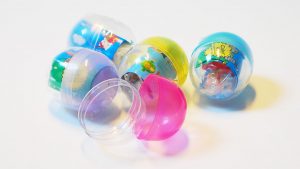 Related ReadHow to Design a Gacha SystemIn MonetizationAdam Telfer
Related ReadHow to Design a Gacha SystemIn MonetizationAdam Telfer
The Summoning Gacha
Centrepiece of all character gacha games, Cygames’ main gacha cleverly extends the pool of gacha content by adding Wyrmprints and Dragons to the mix. There are 70 launch characters, a base upon which other games could build their entire game, plus 40 dragons and almost 80 Wyrmprints (190 droppable pieces in total). While some of these are currently event-only, the amount of content for the base gacha is staggering, particularly as Wyrmprints and Dragons require many duplicates to be useful in the long run, and can only be equipped on one character!
The large amount of content allows Cygames to be very generous in offering players spins on the gacha, and hence hooking them to the mechanic.
Adding to that, Cygames also applies a “pity mechanic” that increases the chances of pulling a 5 star item (character or otherwise) after a certain amount of summons without 5 star success. This prevents spender churn due to perceived lack of fairness.
While both of these methods sound generous, the chance of getting a rare Wyrmprint is still twice that of a character, and many players end up with these instead of their true desires.
Duplicates can be fed as XP boosters to their own kind, with the exception of characters, who are substituted by a currency called Eldwater, which is used to promote lower characters to a higher rarity and unlock high level skill boosts in mana circles. What is important to note is that at of yet, there’s no endless sink for Eldwater, meaning that at some point the currency becomes useless to high spenders – I will talk about this again in the live service segment.
A crafty way to turn more players into payers is the structure of the gacha summons: a single summon is 150 Wyrmite or Diamantium, the ten-fold summon at 1500 Wyrmite/Diamantium guarantees a 4 star item. The daily single summon ,however, only costs 30 diamantium, meaning that the paid-for premium currency is vastly superior when used in daily trickles, keeping spenders playing!
Item Gacha
Since players are in constant need of a variety of currencies and crafting materials, they get a free spin at the item gacha, which returns a small amount of them. Conveniently living in the shop, this daily habit makes sure players are exposed to any special deals they might want to make use of – or to buy the missing ingredients they hope the item gacha would return.
The item gacha fulfills two important purposes: the first one is to get players to visit the in-game shop daily and come in contact with all potential purchasing offers.
The second is to ensure that players can’t miss out entirely on anything they might need in case they lose overview of the system, or have trouble grinding. Dispensing all types of the commonly needed progression resources, it ensures a minimum amount of power growth, even if a player isn’t fully efficient.
Randomized Battle Rewards
Each time a player fights a battle, they receive a few consistent resources: rupies and mana. On top of this, each level has a drop table of random rewards, that includes weapons and even low-level Wyrmprints. So to find the more tertiary resources only found in drop tables, players need to not only select the right level and fight difficulty, but also get lucky.
There is a small skill component to battle rewards in the form of treasure chests that can be found during battle for going out of one’s way, but their contribution to overall results is relatively minor.
If players need to desperately acquire a certain resource, they have the choice to either fight for randomized these rewards and potentially spend on stamina refills, or they have to buy these resources in shop packs and the item gacha.
Knowing what is the best way to acquire an item, and consequently where to spend most efficiently, is often not clear. This reduces the appeal for players who are used to easily understood power growth, and who are time poor.
At 40 Wyrmite for a stamina recovery, 50 (base) Wyrmite cost for an item summon, or around 30 USD for a pack that contains the item, Dragalia does not make acquiring an distinct item a straightforward purchase decision, either.
Dragon gifts
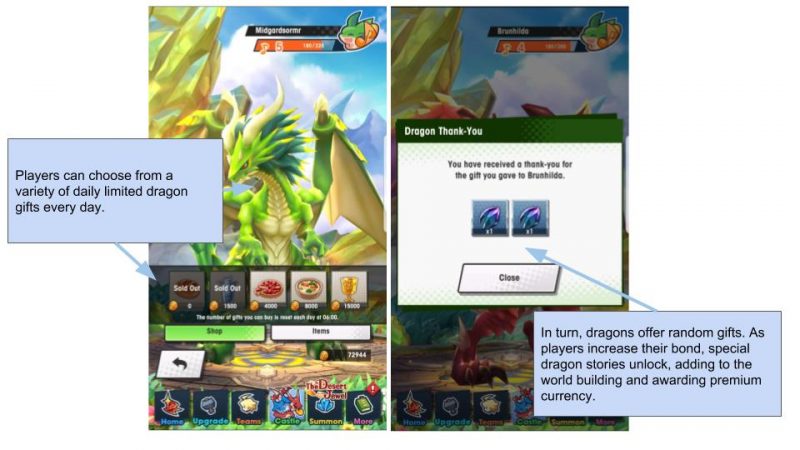
When gifting to Dragons (which costs Rupies or special purpose items), they offer a random set of goodies in return, along with their increase in dragon bond.
Since Dragon gifts are not very predictable or good return of investment, they are not a good way for the player to advance their progress. However, Talonstones, as pictured above, are given at certain bond levels, which makes leveling dragons relevant at specific points in the upgrade journey.
Event Gacha
If the recent events are anything to go by, Cygames are offering a special gacha type for their unique events. Unlike the other gachas, however, it is a finite gacha (also called box gacha), meaning that once an item is taken out of the pool, it cannot be rolled again. Players get full visibility on the current contents, and are even allowed to reset it, putting things back into the pool. This allows players some influence on whether they want the remaining items guaranteed or have another chance at getting the super rare drops, assuming they have already been removed from the pool.
Having this much of player progression be determined by randomized rewards systems allows for many more spending opportunities and make it easier to obfuscate balancing changes.
Live Service
There are two main ways in which Cygames currently keeps the game fresh and their players engaged: Gacha events and limited time special events.
Gacha Events
Gacha events are large-banner introductions of new characters and items to the common gacha pool. These characters have a highly increased chance of appearing (currently 0.5% instead of 0.05% for other 5 star characters) and are particularly suited to whatever the current special event challenges at hand are.
 Related Read3 Reasons Why Dragon Ball Z: Dokkan Battle Reached #1 Top GrossingIn Monetization, Top PostsAdam Telfer
Related Read3 Reasons Why Dragon Ball Z: Dokkan Battle Reached #1 Top GrossingIn Monetization, Top PostsAdam Telfer
Oddly, Cygames makes no direct reference to enforce this connection, showcasing how the game accepts that players have to figure everything out by themselves, bleeding even into their monetization methods.
Limited Time Special Events

Dragalia’s current and so far only format of LTE has essentially three segments:
An engagement mode, where a new character is introduced that players are given to play with for free. This character only stays if players have won enough fights with them to increase their “friendship level” to maximum. Event fights give more points. This segment is achievable for all engaged players to complete.
Boss Battles can be completed on their own or in coop mode and hence allow players who do not want or are not able to participate in synchronous coop to earn event gacha currency, emblems (engagement rewards) and raid access tickets.
Raid Battles are coop raids only, with four players bringing in whole teams of four characters each! This is where players can earn the highest tier gold emblems and hence the best rewards.
Coop raids cost special stamina AND require the access currency from the Boss Battles, making them real stamina pinches, particularly since grinding high amounts of access currency will also cost stamina.
The true end rewards of the special event are multiple copies of the featured 5 star dragon, summoning vouchers for free gacha pulls, ultra-rare items needed for highest mana circles, “joker” items that can unbind any dragon or rare weapon ingredients.
Because all of these items are either event exclusive or barely obtainable by other means, events are a necessity for top players. Not performing well in events affects their core game performance, causing them to be heavily invested in these social coop raids.
Future Problems
The current systems design and live service model of Dragalia will likely lead to difficult endgame management.
First there is the fact that in absence of a mode that creates content on its own (such a PVP mode), players who have all or most of the standard content have nowhere to meaningfully play. There aren’t even leaderboards for the most event victories or any other measure of competitive success or dedication that keeps top players pushing.
The only motivation that keeps top players in the game is collection of future characters. This system means that future events either always need to yield the new most powerful character (power creep) or monetization will decline as players have no power-driven motivation to acquire them.
Secondly, duplicates including the substitute currency for characters, Eldwater, do not have an endless sink. This means that further spins on the gacha are a waste of money and literally return zero game state change. Top players will end up with large quantities of barren items und currency stocked up, making them precarious for use by the liveops team in the future.
Both the gameplay and the systems economy in Dragalia have distinct endpoints. Currently the solution seems to be to make the top resource acquisition incredibly grindy, which is another feature that will reduce long term appeal in the West.
Generous Rewards
One of the first things you will notice playing Dragalia Lost is how generous it is with dispensing its premium currency Wyrmite. You literally get it for everything from fighting battles, to completing dailies, to simply reading the stories of the various characters. Usually you can get enough to complete a multi-summon every day or two. There are three reasons Dragalia hands out its premium currency so freely compared to most western games.
Get you used to spending
In my opinion this is something that the Japanese developers, who first introduced this system to the mobile market, have always done better than their western counterparts: For a gacha game to truly work, gacha must be the habitual center of the game. Everything revolves around the gacha, and players must get used to it being the prime source of their progress first. To that end, sacrificing some early monetization to have people spend more in the long term is an acceptable trade-off.
Get you into the game
Mid-core games (Japanese-made in particular) tend to be complex affairs with many features, taps and sinks. Since most midcore games rely on good long term retention to make use of their feature depth, heavily incentivizing players to stick with the game until they have learned the ropes and are committed is beneficial.
Incentivize certain behaviours
The high granularity of Wyrmite (1500 for a multi-summon) allows the team to trickle small amounts everywhere to incentivize behaviours. Because the currency is so valuable players can easily be directed towards the features deemed most important. As an example, playing socially with new players in coop mode will yield a staggering 150 Wyrmite per fight.
Leave a Reply